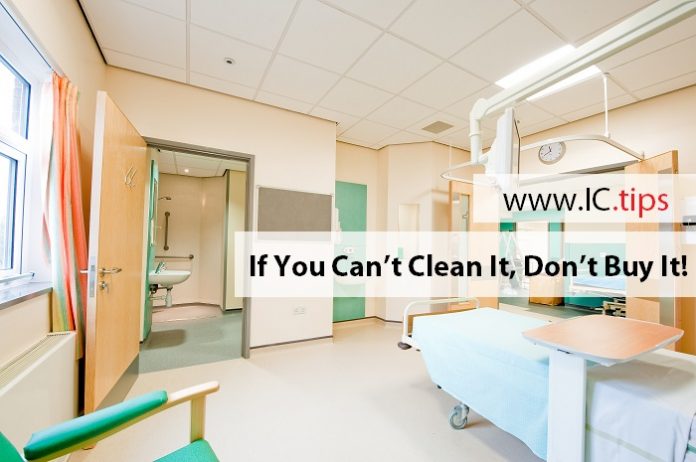Abstract
A number of factors ought to be considered when purchasing equipment for use in hospitals. At our March 2017 Showcase at our Center of Excellence for Infection Prevention and Control in Buffalo New York, Keith Sopha , presented the case that the ability to easily clean equipment and surfaces in hospitals should be one of the deciding factors when making purchases. All surfaces are potential reservoirs for harmful pathogens, and making them easy to clean can save countless lives.
Main Article
“If you can’t clean it, don’t buy it.” It’s a simple statement from Keith Sopha, adapted from the Provincial Infectious Diseases Advisory Committee (PIDAC, Ontario, Canada) (Public Health Ontario, 2015). In healthcare, the latest hot issue is hospital acquired infections. In healthcare design, the decision to use particular materials and products is in part due to its ability to be cleaned (Sopha, 2017). Despite the greatest technologies available, surfaces that are difficult to clean still present a very real danger to staff and patients. Thus, it is suggested that Infection Prevention (IP) personnel and Environmental Service Professionals (EVS) be involved in the purchase decision.
In the PIDAC document, it is recommended that all hospitals have clear policies on the types of surface finishes, furniture and equipment that are acceptable for use in their facilities (Public Health Ontario, 2015). This list should be regularly amended, but the decisions should be made by a collective of purchasing managers, occupational health and safety, infection prevention personnel, building services (maintenance), environmental services (cleaning staff) and nurses (Sopha, 2017).
there are numerous factors that are important when choosing products
Buy in from all these staff groups is needed, as there are numerous factors that are important when choosing these products; most notably, the ability to be cleaned, and the compatibility of the equipment/surfaces with hospital disinfecting protocols should be considered. This is usually achieved by selecting products that are easy to maintain and repair, durable against caustic chemicals, resistant to microbial growth, non-porous, and seamless.
Textiles
Cloth and soft furnishings can act as reservoirs for pathogens. They are typically porous, and thus are more resistant to cleaning (Takai et al, 2002). However, in a hospital, textiles are unavoidable. In recent years, there has been a switch to the use of fluid-resistant and non-porous fabrics that can be cleaned with typical hospital cleaning agents (Mitchell et al, 2015).
Carpets have been associated with an increased risk in HAI’s in hospitals. In particular, Clostridium difficile has been identified in numerous carpeted surfaces (Harris et al, 2010). In many hospitals, carpeted surfaces are banned from rooms that house immunocompromised patients.
Research and Outcomes
In a recent audit performed by Wendy James (ICP at Guelph General) and showcased by Keith Sopha, it was found that the use of inappropriate furniture was still prevalent at the hospital. High risk of contamination items included chairs with wooden components, cracked or damaged upholstery on furniture, multiple fabric covered chairs, and numerous instances of out-dated wooden furniture (Sopha, 2017). Microbial analyses of these samples identified the presence of both methicillin-resistant Staphylococcus aureus and C. difficile. These species were less prevalent, but are potentially the most pathogenic. In the majority of samples, the presence of other microorganisms, such as Bacilli or Enterococcus were present, but these were not characterized further (Sopha, 2017). Both genera can originate from fecal contamination.
Learning from Mistakes
The potential reservoirs for infection in hospitals, and that are frequently found in old hospitals, are becoming obsolete in newly designed hospitals. The removal of wooden and porous surfaces, in addition to ensuring that equipment is easily cleaned, greatly reduces the potential for HAIs. A disappointing step backwards can be found within a new facility in Ontario, Canada, which is installing wood features in its birthing room. Wood surfaces are porous and may harbour microorganisms once the wood coating starts to break down from cleaning and disinfection.
References:
Harris, D. D., Pacheco, A., & Lindner, A. S. (2010). Detecting potential pathogens on hospital surfaces: an assessment of carpet tile flooring in the hospital patient environment. Indoor and Built Environment, 19(2), 239-249.
Mitchell, A., Spencer, M., & Edmiston, C. (2015). Role of healthcare apparel and other healthcare textiles in the transmission of pathogens: a review of the literature. Journal of Hospital Infection, 90(4), 285-292.
Public Health Ontario (2015) Provincial Infectious Diseases Advisory Committee Report. Public Health Ontario. Accessed Apr 5, 2017 https://www.publichealthontario.ca/en/BrowseByTopic/InfectiousDiseases/PIDAC/Pages/PIDAC.aspx
Sopha K (2017) If You Can’t Clean It, Don’t Buy It. Buffalo NY, Showcase. March 30, 2017.
Takai, K., Ohtsuka, T., Senda, Y., Nakao, M., Yamamoto, K., Matsuoka, J., & Hirai, Y. (2002). Antibacterial Properties of Antimicrobial‐Finished Textile Products. Microbiology and immunology, 46(2), 75-81.
LAST UPDATED: April 9, 2017













two quick comments on the image – the waste on the en-suite sink is exposed and will be difficult to clean. As the en-suite bathroom is part of a clinical zone it should be treated as such. The he sink should therefore have a concealed waste as you would find on a clinical wash basin. There may also be un-glazed porcelain at the back of the sink which will not be smooth and non-absorbent. Secondly, the low surface temperature radiator is not a sealed unit and the heating element is not easily cleanable. The fins on the element capture dirt and dust from the air intake at the bottom and this becomes a reservoir for infection, which is then released by convection out through the grill at the top.